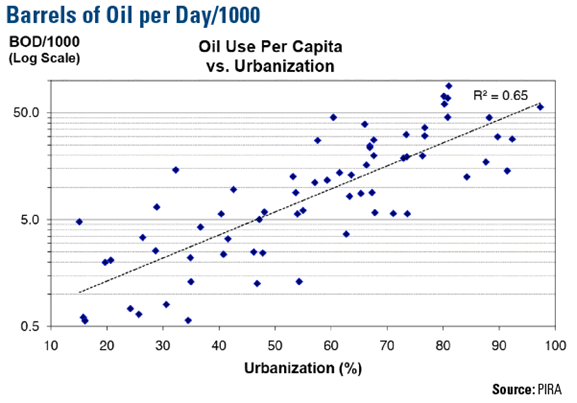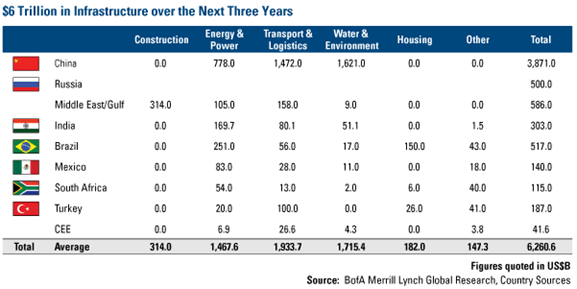Emerging Market Infrastructure Set to Drive Demand for Commodities
Economics / Emerging Markets Oct 05, 2010 - 11:11 AM GMTBy: John_Derrick
 Every week roughly 1 million people are born in or migrate to cities in emerging markets all over the world. By 2030, the global urban population is expected to grow by 1.6 billion people and account for 60 percent of all people on Earth, according to the United Nations.
Every week roughly 1 million people are born in or migrate to cities in emerging markets all over the world. By 2030, the global urban population is expected to grow by 1.6 billion people and account for 60 percent of all people on Earth, according to the United Nations.
With more people to feed, house, transport and keep warm, many emerging market metropolitan areas are buckling under the pressure. A month-long traffic jam near Beijing caught worldwide attention in August. According to Merrill Lynch, the daily commute for an average office worker in China is twice as long as it is in the U.S.
Over the last two weeks we have shared with you charts demonstrating the rising demand and prices for metals and oil due to the robust rising economic activity in emerging markets. The visual below reflects the high correlation between oil demand and urbanization, which drives infrastructure spending.


India is struggling to fulfill the most basic needs of its population. Nearly 40 percent of India’s population doesn’t have access to electricity and almost 400,000 children die each year from waterborne diseases because they don’t have access to clean water.
Russia relies on Soviet-era roads and infrastructure to transport its natural resources to key export hubs. Many of these roadways haven’t been updated since the early 1980s. Russia’s roadways currently rank near the bottom for quality when compared to others around the globe.
Brazil may have the widest infrastructure gap of the BRICs. The country’s investment as a percentage of GDP has been declining since the 1970s and dropped to just over 2 percent in the 2000s—roughly the same amount as the U.S. The underinvestment shows; the country ranks in the bottom quartile globally for quality of roads, quality of ports and quality of airports.
In order to get back on the right track, substantial investment is needed in global infrastructure. Merrill Lynch forecasts that more than $6 trillion in investment is required over the next three years—80 percent being invested in the BRICs. We believe commodity prices could exceed most analysts’ expectations.

Of emerging market countries, China is far and away the big spender. This table shows the investment breakdown by category. You can see that more than 81 percent of the funds go toward three areas: Energy & Power, Transport & Logistics and Water & Environment.
The spending outlined above should be a huge demand driver for commodities such as oil, coal, iron ore and for materials such as steel and cement. Equipment and construction companies could also benefit. We believe it is similar to the California gold rush when the people who made the most money weren’t the prospectors but the suppliers who sold them their picks and shovels. Water-related, transportation and logistics companies may also turn out to be accessories to the boom.
Because of rapid urbanization, decades of underinvestment and strong fiscal balance sheets relative to the developed world, the stage is set for a massive global infrastructure build-out in the emerging world.
By John Derrick
John Derrick, CFA, is director of research at U.S. Global Investors, which manages mutual funds specializing in natural resources, emerging markets and global infrastructure.
For more updates on global investing from Frank and the rest of the U.S. Global Investors team, follow us on Twitter at www.twitter.com/USFunds or like us on Facebook at www.facebook.com/USFunds. You can also watch exclusive videos on what our research overseas has turned up on our YouTube channel at www.youtube.com/USFunds.
Please consider carefully the fund's investment objectives, risks, charges and expenses. For this and other important information, obtain a fund prospectus by visiting www.usfunds.com or by calling 1-800-US-FUNDS (1-800-873-8637). Read it carefully before investing. Distributed by U.S. Global Brokerage, Inc.
All opinions expressed and data provided are subject to change without notice. Some of these opinions may not be appropriate to every investor. Gold funds may be susceptible to adverse economic, political or regulatory developments due to concentrating in a single theme. The price of gold is subject to substantial price fluctuations over short periods of time and may be affected by unpredicted international monetary and political policies. We suggest investing no more than 5% to 10% of your portfolio in gold or gold stocks. The following securities mentioned in the article were held by one or more of U.S. Global Investors family of funds as of 12-31-07 : streetTRACKS Gold Trust.
John Derrick Archive |
© 2005-2022 http://www.MarketOracle.co.uk - The Market Oracle is a FREE Daily Financial Markets Analysis & Forecasting online publication.



